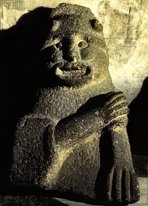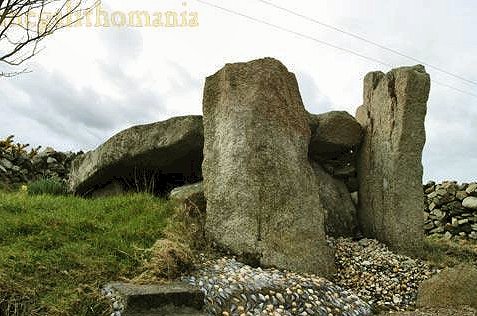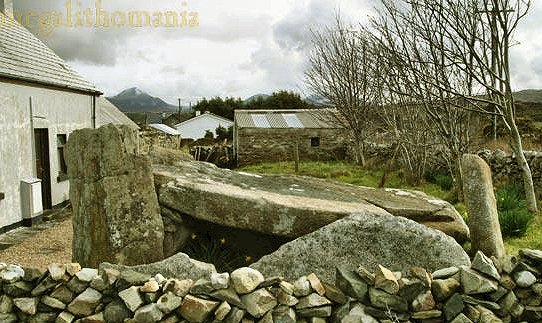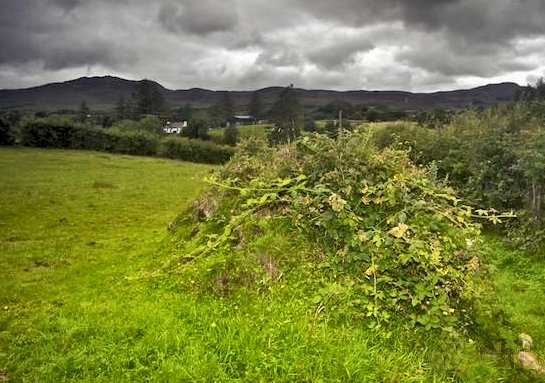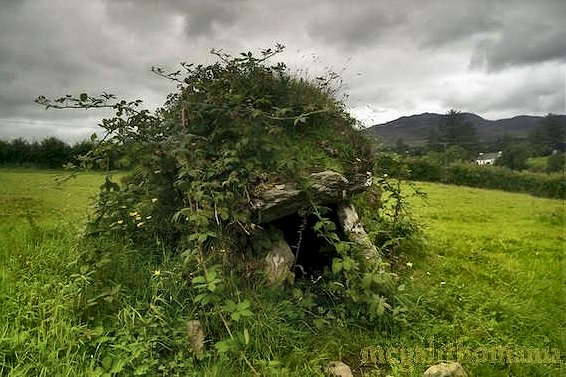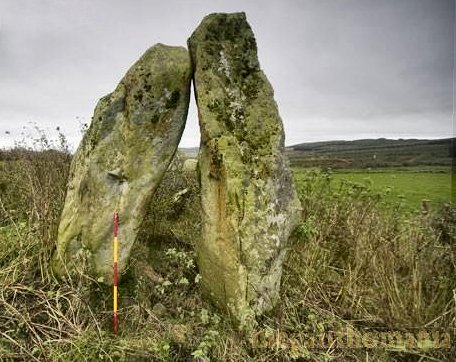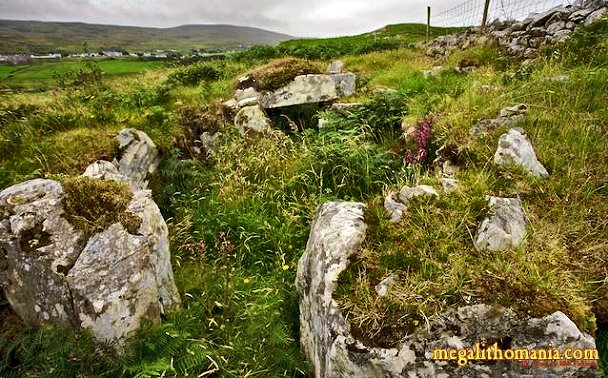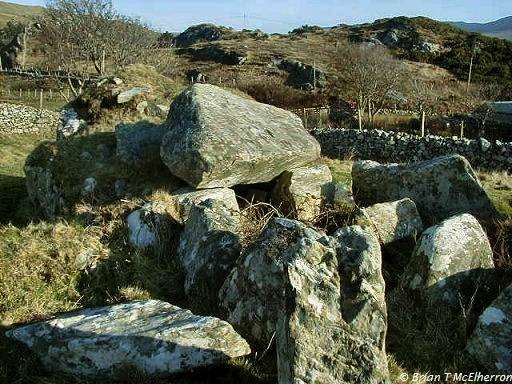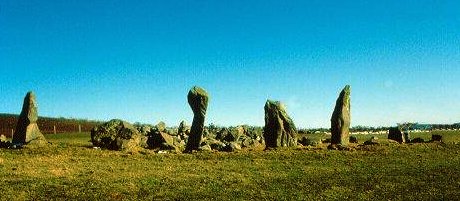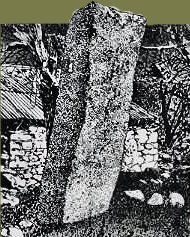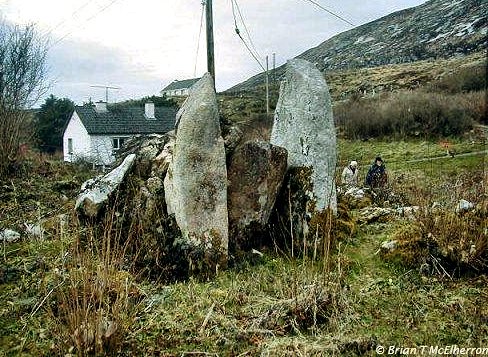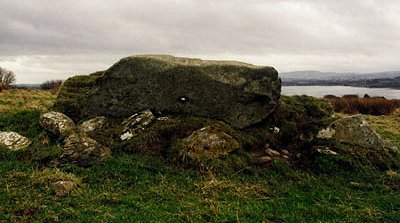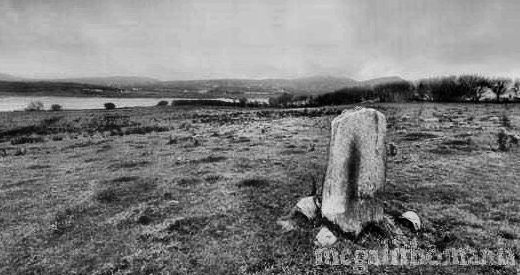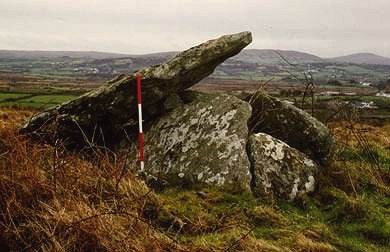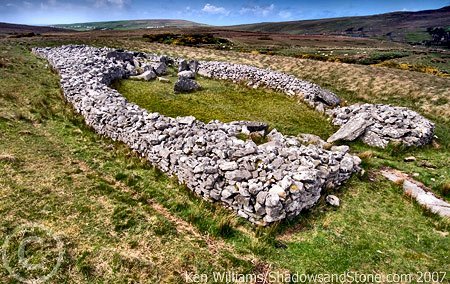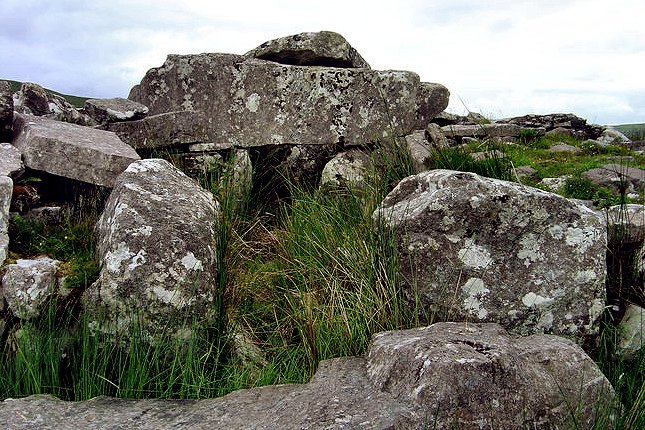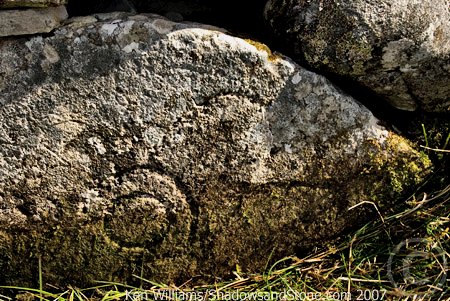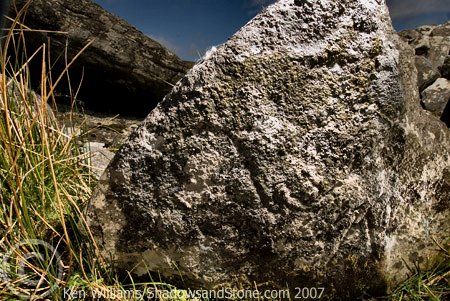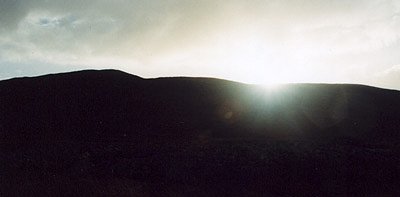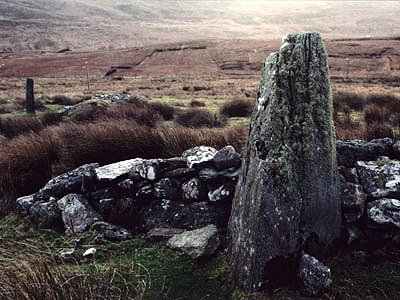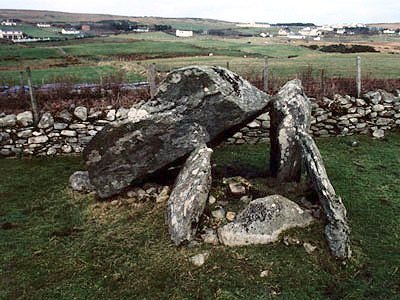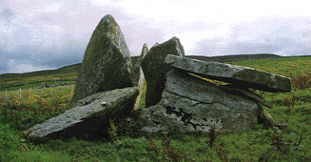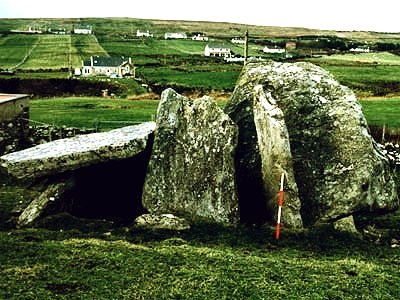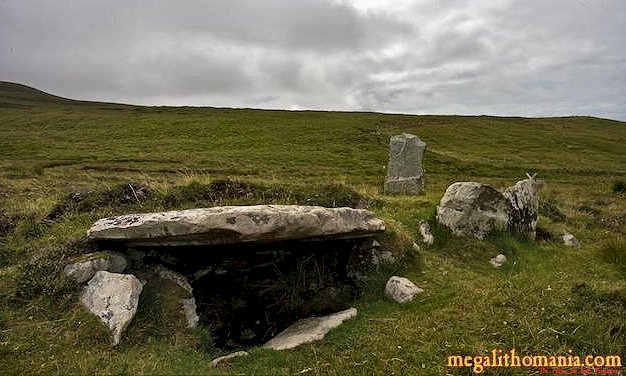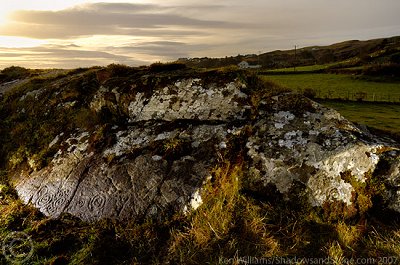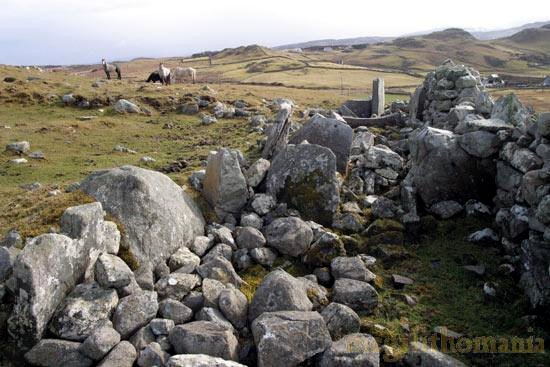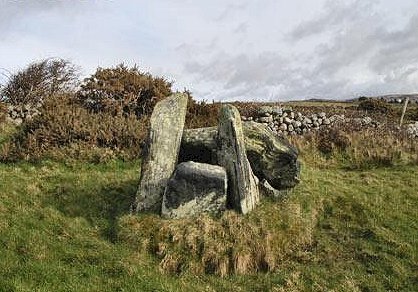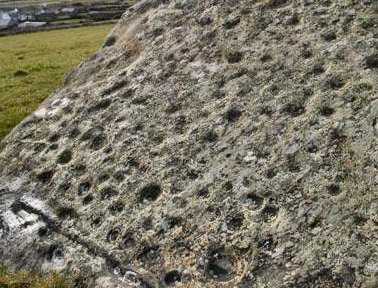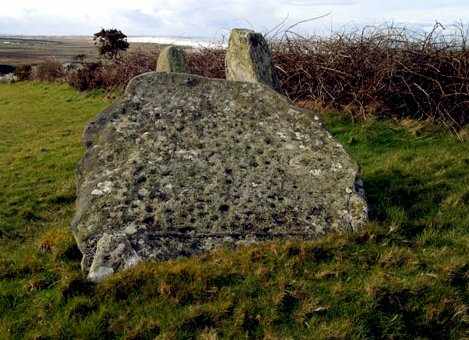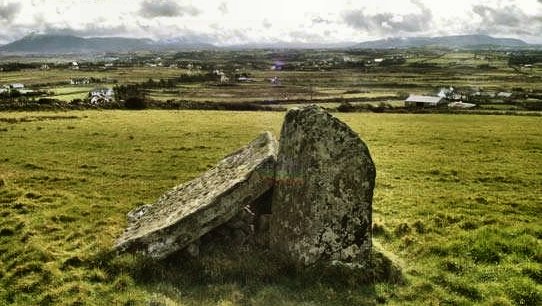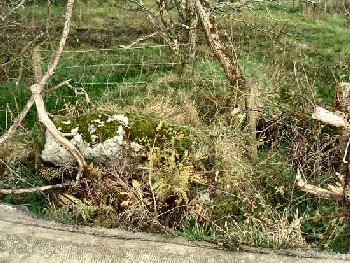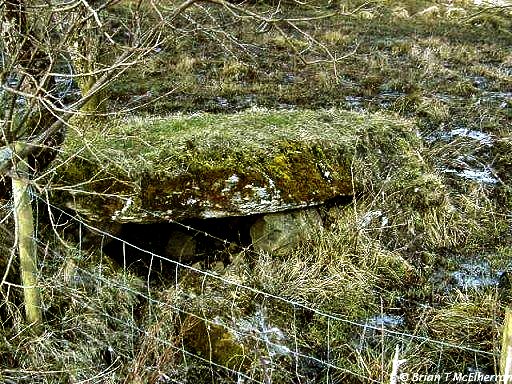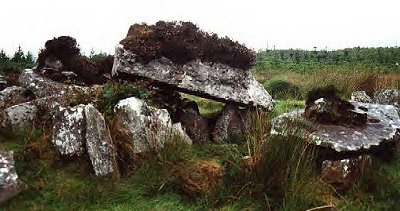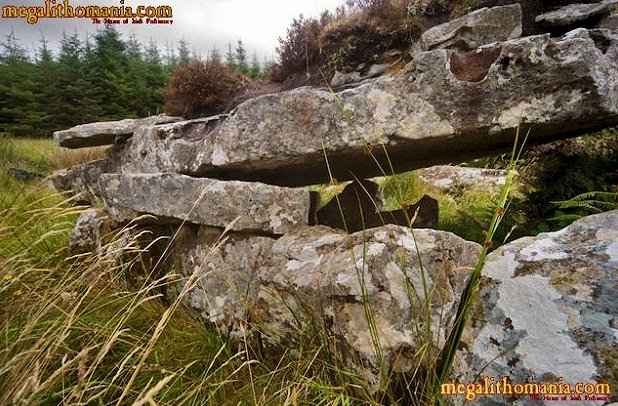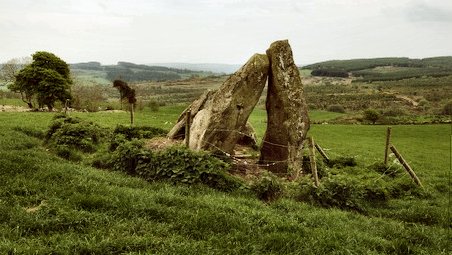county list
|
Turn smartphone to horizontal
view. SELECTED SITES IN COUNTY DONEGAL Place-names in italics refer to listed entries. Convert Irish Grid references to Latitude/Longitude |
|
In a field 1.6 km NNE of the village of Muff, stands a rectangular, grooved block 2.1 metres high, and decorated on the S face with around 40 cupmarks of which about half are surrounded by 1, 2 and 3 worn rings. ~ 2.3 km WNW in Eskaheen (C 451 271) is a collapsed portal-tomb whose huge 5 by 4 metre capstone covered a very small chamber and was originally held up by portal-stones (now prostrate) which were 2.4 metres high.
Ards
Beg: Portal-tomb Until the early 20th century at least, the capstone of this tomb was still resting on stout portal stones and the chamber walls seemed to be upright. Now one side of the chamber has collapsed beneath the weight of the 4-metre capstone, which has also slipped from the portal stones. The stones from the other wall have been pushed outwards. Worse, however is that the tomb now stands in the rear garden of a bungalow, which has been built just 2 metres in front of the portal. To add insult to injury one of the portal stones has been secured upright by a nasty looking blob of concrete, "enhanced" by having mussel shells pressed into it. A loose scatter of shells, presumably taken from Binanea Strand which the tomb overlooks, has been placed in front of the low doorstone.The gallery is around 3 metres long and just over 1 metre wide. The portal stones are 1.8 metres tall with a half-doorstone in between. The central axis is aligned nearly east-west with the entrance facing south of east towards Muckish Mountain.
Ballymunterhiggin:
Centre-court tomb This extensive tomb lies in a grass-grown cairn 45 metres long, 2 km south of Ballyshannon, some distance across fields from the nearest road. The oval court has 2 two-chambered galleries, one with a lintel-stone in situ. Two subsidiary chambers are opposite the narrow entrance on the S side of the court, and a third subsidiary chamber opens into the court immediately W of the entrance. ~ About 8 km W, in Magheracar, is a small cliff-top wedge-tomb - see under Wardhouse, county Leitrim. Barnes
Lower: Decorated standing-stones Two massive standing-stones under a metre apart stand immediately E of a by-road leading towards Crockmore. The larger one, a massive slab over 1.8 metres square, has many cup-marks (some with large rings) and wide, shallow grooves on its E face. The smaller one, shaped like a spearhead, has cupmarks and a cross (a relic of Penal times ?) on its W face. Both faces are lit simultaneously in late morning. ~ In the same townland (C 122 263), on high ground overlooking Lough Salt, is a three-stone row whose highest stone is 1.2 metres. ~ 400 metres N of the stones is an interesting but overgrown court-tomb with long lateral galleries set transversely to the main gallery. ~ 5.2 km ENE of the standing-stones, at Carrownaganonagh (C 159 256) is a small wedge-tomb. From the field-gate it looks a bit like a sweathouse - but it is actually a narrow mound containing a narrow chamber roofed with a single stone. A narrow opening at one end leads into the gallery, which is 3 metres long and 1 metre wide. A small chock-stone has been inserted to keep the roofstone level.
~ 6 km SSE in the main street of Kilmacrenan (at the bottom of the hill in a laneway on the left-hand side, going down the hill towards the bridge: C 141 204) is an egg-shaped bullaun stone, with a 30 cm basin at the fatter end, and a much smaller depression near the other. ~
7.2 km SE in Letter "The Labba Rocks" (C 165 197) are
a court-tomb in a wedge-shaped cairn, sited near the top of
a hill and affording fine views. Many kerbstones survive, and
roofstones are strewn about. ~
Farther SE again in Cloghroe (C 134 007) is a roofless
portal-tomb whose west-facing entrance stones are 3 metres high.
One of them is leaning against the other, whose inner edge has
been 'trimmed' or 'shaved' so that the lower part is smooth
and vertical. The tomb is next to the road on a small, raised
prominence that overlooks a shallow valley to the south. There
is possibly some of the original cairn material under the grass
on the north side of the tomb, but this could be a build-up
of soil that has washed down the slope and built up against
the remaining stones.
Carnaghan: Portal-tomb 400 metres W of a road-junction on the former island of Inch, the portal-stones of this tomb-among-the-trees are very impressive at over 2.5 metres high - although the roofstone is gone. Behind these is a large, secondary kist-chamber about 1 metre deep, covered by a capstone 2.4 by 1.8 metres which sits on several variously-sized chocking-stones. A couple of side-stones (one fallen) and some of the cairn (greatly reduced by ploughing) survive. Drumboghill:
Stone fort
(Doon Fort)
and crannóg click
on the thumbnail for a larger picture Set in superb landscape and in the middle of Doon Lough (boats can sometimes be hired), one of many thousands of Irish crannógs (small artificial island-refuges) has sprouted an impressive stone fort, partly-restored. It is terraced with steps on the inside and has wall-passages which may be original. The walls (3.6 metres thick at the base) stand to 4.5 metres high. From the mainland a fine view can be obtained of the S side of the fort and its damaged entrance. It is also known as O'Boyle's Fort, and The Bawan. ~ About 800 metres WNW on an island in Lough Birrog, up a stone-flagged causeway leading from the shore, is another (ruined) stone fort.
Farranmacbride: Centre-court tomb Glencolumbcille is famous for its turas, or devotional pattern on the 9th of June, along a given route which is punctuated by stations. Most of the stations feature beautiful early-christian cross-slabs and cairns, but two are in fact megalithic tombs. The one in Farranmacbride (part of the ninth station, 400 metres N of the church of Glencolumbcille), close to a perforated standing-stone "through which Heaven may be glimpsed" by the pure - or devout - "and barren women made fertile", is a huge ruined court-tomb, some of whose chambers have been used as livestock pens. Also known as (The) Munnernamortee Cave, two large twin-chambered galleries open on to a central court about 21 metres in diameter (the biggest in Ireland) - most of whose orthostats are missing. The SW area of the court is crossed by a sunken track. Three subsidiary chambers are set around the court, occurring more or less where the façades of facing single-court tombs would have ended. This tomb seems to be one of the many "experimental" or "culturally-diverse" in the NW, and has some similarities with those at Tullyskeherny in county Leitrim. The cairn is an amazing 60 metres long, spread over two fields. A line along the axes of the two galleries passes directly through Station 2 of the turas (100 metres down the road from the church), which is a 3-metre high rock-outcrop with a cross pillar on its summit. Such rock-outcrops occur at or near many court-tombs and obviously had great significance.
Summer and winter photographs of W and E galleries.
~ 3.5 km SW are the tombs in Malin More.
Glackadrumman: Stone circle Also known as the Bocan stone circle, only seven stones still stand out of at least 12 reported in the early 19th century.. They are between 1 and 2 metres high and now form two arcs. There are also several fallen and broken stones which partially enclose an area about 20 metres in diameter, whose centre is a dump caused by 'field-clearance'. ~ About 800 metres SSW in Laraghirril are the impressive remains of a court-tomb which lacks a court but whose gallery is well preserved. At the E end a pair of double jambs less than 1 metre high seem to mark the entrance. The gallery is about 9 metres long and is divided by high jambs and a double sill into two chambers of roughly equal length and about 2.5 metres wide. The back stone of the inner chamber is missing. Vestiges of the cairn remain.
Gortnavern:
Portal-tomb click
on the thumbnail for larger pictures Dermot and Grania were two illicit lovers who eloped and slept in a different wild place every night. This picturesque "Dermot and Grania's Bed" (different from every side) has a chamber of 5 slabs set on edge (one fallen), and covered by a slipped (and characteristically tilted) roofstone 3.6 metres long, which is raised 2 metres off the ground by the portal-stones. There are 5 cupmarks on the upper surface. The views from the site are splendid: Mulroy Bay is just visible to the NW, while to the NE Knockalla Mountain looks like a sleeping giant. ~ 5.6 km ENE in a boggy field next to a road in Drumhallagh Upper is a court-tomb (C 276 318) whose 10-metre long gallery has two chambers, the rear one looking very like a wrecked portal-tomb. No roofstones are in place, but the many stones strewn about are remains of the kerb of a vanished trapezoidal cairn. Grianán
of Ailech: Stone fort Unfortunately over-restored in the last century, this fine fort (also known as The Greenan, and Grianán Ailighe) offers magnificent views of Loughs Foyle and Swilly and the countryside round about from its position on top of Greenan Mountain. This is one of several monuments to be (latterly at any rate) associated with the sun (Grian in Irish). Around the imposing stone wall (up to 4.5 metres thick and 5 metres high) are the remains of 3 earthworks which presumably pre-date the fort, which may have been built as late as the 6th century. The walls were only 1.8 metres high before enthusiastic restoration was carried out; there were originally 2, not 4, stairways, and the terracing is obviously wrongly reconstructed. There are 2 wall-galleries entered from within the fort, which was the seat of the O'Neill sept of Aileach from maybe the 5th to the 12th century, and is mentioned in the Annals of Ulster as late as 1100 C.E. ~ 6.4 km NW are Carnaghan portal-tombs.
Kilclooney More: Portal-tombs click
on the thumbnail for larger pictures Approached
via a grassy lane behind Kilclooney Church, the larger of the
two portal-tombs changes shape as you go round it: now a Mexican
hat on legs, now a wingless bird or Concorde aircraft. Portal-stones
1.8 metres high support a massive roofstone 6 metres across.
Between the backstone and the roofstone is a fine example of
a chocking-stone set to get the characteristic angle of tilt
just right. The small tomb, at the other end of the remains
of a long cairn, still has 2 sidestones, an inset backstone
and one portal-stone, and is roofed with a horizontal slab.
Both tombs have low sillstones at the entrance to E-facing chambers,
but are not built on the same axis. However, the larger tomb,
the smaller tomb and a large standing stone 40 metres away do
form a straight line. ~ 350 metres W by N, 60 metres E of the road, is a court-tomb with corbelling on part of the S side, and one of 2 displaced lintels still spanning the gallery. ~ About 800 metres SW (G 713 962), is another small, roofed portal-tomb. ~ 5 km SSE and 1 km N of Ardara village is Owenea standing-stone, a massive block some 3.5 metres high in a scraggy field behind a ruin.
~ 8.8 km NE in Toome, close to the N tip of Toome Lough is "Dermot and Grania's Bed" (B 791 015), a long cairn incorporates two portal-tombs, some 10 metres apart. The larger of these faces E into the cairn and has portal-stones 2 metres high flanking a door-stone 1.2 metres high. The slipped capstone is partly supported by exterior corbels outside the low sidestones. The backstone is gabled: a feature of many court-tombs. The roofstone and doorstone are of limestone, while the rest are of granite. The other tomb also faces E, is more ruinous, but has massive sidestones.
In the neighbouring field is a stone about 80 cm high with an inscribed, equal-armed cross about 25 cm square. It is greatly worn but there appear to be T-bar terminals on the arms of the cross and a triangular terminal on the shaft. Magheranaul:
Wedge-tomb, Standing-stone and rock-scribings (petroglyphs)
Just over 100 metres N of a by-road running E towards Malin, this interesting "Giant's House" - more suitable for a hardy dwarf than a giant - has a grass-covered, wedge-shaped roofstone over 2.5 metres long and 1.2 metres wide, covering a long, low wedge-shaped chamber bounded by 2 long sidestones, a backstone, and a massive single door-stone pierced by a hole 15 cms in diameter and 18 cms deep (illustrated below), obviously cut from both sides of the slab. "When there was thunder and lightning, the giant (or ogre or dwarf) went in, put his finger through the hole and pulled the door to." It seems unlikely that there was a portico or antechamber in front of the door-slab. ~ 1200 metres SSE, near the shore (C 433 495) is a standing-stone 1.4 metres high.
~ In the next field W of the standing-stone (C 426 500) were four separate rock-surfaces decorated with cups and rings, parallel grooves, cups and gapped-rings with radial grooves, and 'cartouche' motifs. Unfortunately most of them were wantonly destroyed in 1988, like the Ballinloughan petroglyphs in county Louth. click
on the thumbnail for a larger picture taken in 1975
But near the above, some 500 metres E by S, at C 43228 49720 on GPS, there can still be seen a cup with a tail, surrounded by other radiating lines. ~ 5 km due E, in Drumcarbit (C 48666 49828 GPS), some 5 km N of Carndonagh, is a single stone beautifully incised with 9 penannular rings around a cup. ~ About 1000 metres WNW of the wedge-tomb, to the right of a lane (C 416 506 in the townland of Carrowreagh or Craignacally) is "The Altar" or "Mass Rock", a semi-circular thin slab whose SE face is covered in deeply-incised cross-motifs, which some think to be prehistoric reworkings of existing fissures deepened by weathering. This stone used to be near the petroglyphs mentioned above, but was transported in the iniquitous 'Penal' times to be used as a Mass Rock for the practice of illegal "Papist" rites which could earn the devout a horrible voyage to Australia. The decorations include Norse motifs from Iceland. ~ 6.8 km E in in Templemoyle (C 502 498) is a collapsed but picturesque portal-tomb with fine views to the W towards Magheranaul and SW to the impressive Slieve Snaght. The sidestones and backstone of the small chamber are still in place, but the capstone has tipped forward because one of the portal stones has been taken away and the other leans at an angle. The stick in the picture below is 1 metre high.
~ 5.2 km SW, at Cloontagh (C 397 455) is "Cloghtogle", a curious boulder over 2 metres high and over 3 metres square is supported on small chocking stones at two points and on bedrock at a third. Malin
More: Court-tomb, Portal-tombs, etc. 300 metres from a car-park (through a small gate and across a footbridge across a stream, which in turn allows access to a narrow concrete path across the bog to the marshy court entrance) is Cloghanmore, a remarkable court-tomb, whose court is defined by sweeping arcs that extend in an oval from the unusual twin and parallel galleries that face the entrance. A large stone lies oddly in the centre of the court partially blocking the initial view of the gallery entrances. The court is marked partly by orthostats and partly by dry-walling, indicating an intermediary state between an open forecourt and a full-court. In front of the left-hand gallery is a gabled lintel-stone - which would have looked similar to the one at Shalwy when in place. click
the photo for an aerial view Immediately to the left of the entrance, built into the fabric of the (restored) cairn is a subsidiary chamber, the roofstone of which is propped up gainst its front. To the right of the entrance is a second one with its roofstone almost in place.
Next to each of these chambers are stones with designs in the passage-tomb style - a unique occurrence at a court-tomb.
click for a drawing of the complete stone by Borlase (1897)
At mid-day in midwinter the sun actually rides along a ridge of the mountains to the S - and shines directly into the second chamber mentioned above. Looking southeast from the tomb along the valley another fine phenomenon presents itself: the tip of Lergadaghtan protrudes just above the slope north of Slieve League, giving a likely sunrise alignment at mid-winter solstice. Exhaustive observations need to be made at this site.
A nearby resident recalled that one Christmas Eve she saw lights at the tomb, and thought that the fairies had come for her. She turned off her lights and closed her door and windows, and sat in her chair until dawn broke. Then she went next door to tell her neighbour of her vigil and how frightened she had been. The neighbour had moved there from Germany and was unfamiliar with 'fairy lore'. She said she had felt so sorry for those poor dead people with no one to remember them that she had gone across the road and lit candles for them - a charming tradition in France as well as Germany. Read more on the Voices from the Dawn website.
Click for a view from the top of the tomb towards the sea. ~ Driving west from Cloghanmore, still in the townland of Malin More, in a field on the right-hand side of the road, past a visitor centre are two standing stones, situated 400 metres NNW of Cloghanmore (G 517 830). The taller is over 2 metres high and the other around 1.5 metres.
~ 1.5 km to the W of Cloghanmore lie six very different, ruined or cairn-covered portal-tombs (G 502 825) in a line over 90 metres long, which may all have been covered by one enormous cairn. One of them has a (fallen) 40-tonne roofstone. The usual associated stream winds its way to the sea through the field on the north side of the track. The westernmost tomb is the best preserved, but still difficult to imagine in its heyday. The two end tombs are mimicked pathetically by two houses that are built at either end of the row. Just before the white and green house is a standing stone that seems to be an extension of the line of portal tombs, and a beautiful quartzite block can be seen built into the field wall near to the west end of the row. It has definitely been worked by man and was probably a standing stone associated with this massive monument.
~ At G 504 826 there is an impressive kist incorporated into an ancient wall that runs along the spine of a ridge. Next to it is a small standing-stone.
~ 1.6 km ENE of Cloghanmore (and still in Malin More townland at G 517 831), built into a large drystone wall in a farmyard next to a single-storey house is a portal-tomb whose large capstone rests against the single remaining upright, which is leaning at 45 degrees. This would have originally stood at a height of over 3 metres. One of the side stones of the chamber is also present but not in situ. ~3.5
km NE is the centre-court tomb at Farranmacbride Mevagh: Petroglyphs C 121 396 Sheet 2 Right on the shore and by the roadside on the E side of the Rosguill peninsula (marked "Rock Art" on the map) this is one of the earliest-recorded petroglyphs. Muntermellan:
Portal-tomb click
on the thumbnail for a larger picture Tucked between two rocky ridges overlooking Dunfanaghy, with a fine view across to Errigal and Muckish mountains, about 400 m NW of a by-road leading towards Croaghamaddy Hill at the point where it leaves the water's edge and climbs the hill, this tomb retains a good deal of its cairn. It is also known as The Dane's Cove, and Diarmuid/Dermot and Grania's Bed. Between the two tall portal-stones (2.5 metres high) is a doorstone which closes the chamber. The sides and back are formed by single slabs - one over 3 metres long. One of two roofstones - a table-like horizontal slab rests on 2 corbels (one displaced) on each sidestone. The other, slightly larger roofstone has been displaced and now leans against the W portal-stone. ~ 1.9 km NW in Claggan is a court-tomb (C 003 400) now incorporated into the wall of one of a pair of large oval enclosures. There are several stones remaining of the north arm of the court (illustrated below) and two large jambs lead into a gallery some seven metres long, aligned northwest-southeast (with the entrance at the northwest) on the hill of Cashelmore whose top has been levelled to accommodate a hill-fort or cashel. Quite a lot of the cairn survives. From the site are fine views, notably of the round-topped Crockshee, or Hill of the Spirits whose slopes are dotted with prehistoric walls, enclosures and small cairns.
The most interesting feature is the capstone which leans against the east side giving the impression that that was the back of the tomb, but it is more likely that the entrance faced east. The stone is covered with dozens of small cupmarks.
The views to the west and northwest take in the Atlantic Ocean, and to the southeast Muckish Mountain and its neighbour, Aghla Beg, make a fine pair of features that lead the eye to Aghla More and Errigal Mountain to the south.
photos by Tom FourWinds Shalwy
and Croaghbeg: Full-court tombs Two very fine court-tombs stand close together in adjacent townlands, about 300 metres W of a road junction. Both have fine megalithic lintelled portals and two-chambered galleries. Much of the cairns survives. The Shalwy tomb (Muinner Carn) is well-enough preserved to show careful construction with good joints between the portal-stones and sidestones, so that the chambers of the gallery is not unlike a small ruined stone house of recent date. In the front chamber lies the prostrate door-slab. The lintel is double, and the top stone is gabled. The gallery is roofed by large slabs resting on corbels. To the
SW, The Portabane Carn in Croaghbeg has a fine court
of handsome orthostats set close together and decreasing in
height towards the extremities. The gallery is also impressive,
with massive back-and side-stone corbels, lintels and jambs.
On the N side of the court is a single subsidiary chamber with
jambs and backstone, and, as in the gallery, sill-stones between
the jambs. An interesting feature of the court is the double
coursing of the stones nearest the entrance, matching the height
of the impressive lintel. The tomb is a fine experiment in the
development of Irish court-tombs. From Croaghbeg there is a
fine view S over Donegal Bay to King's Mountain, Ben Bulben,
Knocknarea: an area of county Sligo rich in megaliths as well
as Yeatsiana.
~ A few hundred metres NW of Cashelcummin (G 701 774) is a half-buried wedge-tomb at Largynagreana, whose well-preserved gallery is about 4.5 metres long. At the W (front) end is a small antechamber, about 80 cms deep, separated from the main chamber by a septal stone. There are four orthostats visible on either side of the gallery and these decrease in height from W to E. The capstone of the main chamber is about 3 metres long and is largely covered with sods of grass.
~ 7.5 km E, on the E side of Killybegs Harbour, in Carricknamoghil is a damaged court-tomb (G 727 803) with a track running through its twenty-metre-long cairn, and some bungaloid homes surrounding it. The remains of the main gallery are 5 metres long. There are a few stones remaining from the court in front of this gallery and another chamber lies to the west. This could be a second full gallery indicating that this was a full court tomb with opposing galleries or, more likely, it could be a subsidiary chamber that was built into the arms of a full court near to its entrance. ~ 12.5 km E by N, and N of Dunkineely in Casheltown (G 768 775), about 200 metres E of a by-road at a conifer plantation, up a steep path, is a ?triple wedge-tomb. Three parallel galleries, one metre apart, aligned roughly NNE-SSW, and each with a surviving roofstone, are enclosed by what survives of a single cairn-kerb, 10 metres in diameter, some of whose remaining stones are erect rather than recumbent. Although there is a signpost in Dunkineely for this remarkable site, there are no further indications of where it is.
Tawlaght:
Court-tomb Standing 400 metres E of Lough Nashannagh, the two-chambered tomb has a fine lintel (with a small chocking-stone) over the low entrance, and some large slab-like corbels survive. Only one court-stone can be seen; others may be buried in the cairn-spill which half-fills the court area. The tomb was intact at the beginning of the 20th century, but, as with so many megalithic tombs, the stones were wantonly removed by hunters of small mammals. (This of course also happened in France during the second World War, when the Resistance maquisards were in hiding and hungry.) The nearest source of stone for the tomb is nearly 2 km SE. ~ 8.8 km E by S, in county Fermanagh, is Drumskinny stone circle and alignment. Tops:
Stone Circle and Round Cairn Approached via a farm lane leading W from a by-road running due S from Raphoe, this fine early circle (perhaps contemporaneous with, or a little earlier than, Ballynoe, Down) has over 60 surviving stones which vary in height from 1 metre to over 2 metres high, looking like a jagged crown. This is the kerb of a much reduced cairn (vestiges of which survive in the centre), and is similar to kerbed boulder-circles at Carrowmore in Sligo. Also known as Beltany, it is prominently sited on a hilltop, and affords wide views. Well outside the ring to the SE is an outlier 1.8 metres tall. From the high pillarstone at the WSW of the circle a cupmarked triangular slab at the ENE marks the point where the sun rises on May Day (Bealtaine or 'Beltany'). Another stone also has cup-marks, and there are two standing stones close by behind the woods to the East. ~ 3.2 km SE, across the Deele river in Kilmonaster (C 273 977) is a largely-destroyed megalithic complex of at least eight tombs originally, including a cruciform passage-tomb situated on a low ridge. Surviving parts of the kerb of quartz blocks indicate an original cairn-diameter of 22 metres. 150 metres WSW is a ruined chamber with its capstone displaced: probably the remains of another passage-tomb. The capstone has dozens of shallow cup-marks on it. 'A large quantity of human bones' was dug out in I839. Due E, on the top of Croaghan hill is another ruined passage-tomb. ~ Just under 12 km W in Magheravall (C 134 007) immediately N of a minor road are the remains of a court-tomb, whose two portal-stones stand about 1.5 metres high - one leaning on the other.
~ A further 7.5 km W in Meenbog is another ruined court-tomb (C 059 010) still largely sunk in peat, but nicely situated on top of a small hill with fine views of the mountains to the S.
Twomilestone:
Standing-stone and stone forts (cashels) Situated on the Two Mile Ridge beside a track (neither track nor monuments are marked on the map), a leaning monolith some 2.5 metres high may be associated (but not necessarily contemporaneous) with remains of ancient field-walls, stone walls, low mounds of stones etc. A cashel (probably an ancient cattle-enclosure) is incorporated in the field-system, and there is another one (perhaps a fortified farm) not far away. In a marshy hollow to the E is a pair of small standing-stones, one flat-topped and one pointed: female and male. This site seems to have been in use from at least Bronze Age to mediæval times. ~ 4.5 km ESE in Creevery Upper, SW of Rathmullan (G 928 628) and visible from a by-road are the remains of Dermot and Grania's Bed, a roofless portal tomb with two slab-like portal stones and a door-stone half as high. |

